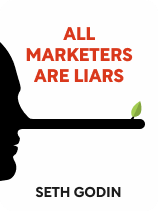

This article is an excerpt from the Shortform book guide to "All Marketers are Liars" by Seth Godin. Shortform has the world's best summaries and analyses of books you should be reading.
Like this article? Sign up for a free trial here .
What are your customers thinking? How do they operate in the marketplace?
Seth Godin explains that customers follow four steps as they navigate the market. When you understand what’s going through their mind and how they make choices, you’re better positioned to get your message through to them.
Continue reading to learn how to understand your customer.
How to Understand Your Customer
Worldviews (customers’ perspectives) affect how and what information the customer takes in. It’s just as important to understand how they process information and make snap judgments. Godin’s second principle of new marketing addresses how to understand your customer. Knowing how your customer thinks can help you break through the noise of other product messages and catch your customer’s attention. Godin identifies four steps customers follow to make snap judgments and navigate the marketplace.
| Cognitive Dissonance Godin titles this section “Cognitive Dissonance” but doesn’t expand on or define the concept of cognitive dissonance. Cognitive dissonance occurs when we hold thoughts or beliefs that oppose or contradict our decisions or attitudes. This might be what Godin is referencing when he says sometimes people can hold two opposing worldviews. Consider a consumer who views themselves as money-savvy, or as someone who likes to save money. That consumer finds a product on sale and decides to buy it, even though he doesn’t really need it. He later feels guilty—why? On one hand, he did save money by purchasing it on sale, but he would’ve saved more by not purchasing it at all. As consumers, sometimes we don’t act in ways that align with our beliefs. |
Step 1: They Notice Change
As consumers, we’re bombarded with so much information that it’s necessary for us to disregard most of it. Think of all the information you face regularly: nutrition labels, prices, billboards, sale signs, recipes, instruction manuals, and more. We can’t take it all in. However, if there is a change in our environment, we’re likely to notice it. That’s why you probably noticed the new coffee shop that opened on your route to work.
Godin recommends that marketers use this knowledge to make thoughtful changes in a customer’s environment to get their attention.
- Take 5-Hour Energy drinks as a case study. When entering the market, 5-Hour Energy had to compete with established energy drink producers like Red Bull and Monster, which packaged its drinks in large cans. 5-Hour Energy chose a different route. They provided their drink in a small “shot” form, so it could be placed at the counter by the cash register. Because of this thoughtful change in the store environment, customers noticed the new product, and 5-Hour Energy was able to succeed in an established market.
| Get Their Attention While Godin believes appealing to beliefs and feelings will get your customer’s attention, Donald Miller thinks you should address basic needs. In Building a StoryBrand, Miller breaks down consumer behavior into two categories: Behavior 1: Meet basic survival needs. The brain prioritizes satisfying nourishment, security, relationships, and meaning. Behavior 2: Ignore complexity—the energy required to understand something complex could be spent on survival needs. To grab a customer’s attention, Miller recommends that marketers present a survival-related message about their product. Let customers know that your product is the answer that will satisfy Behavior 1, and make sure your message isn’t overly complex (otherwise you won’t overcome Behavior 2). Here are some effective messages: Your product will save the customer money, time, or resources. Your product can build relationships or create opportunities for generosity. Your product can help them acquire status. Your product can help them find meaning. So which is the better tactic? You might find more success if you can appeal to both. For example, buying a Ferrari satisfies both: a basic need for transportation and the feeling of luxury and speed. |
Step 2: They Make an Assumption
Once your customer notices a change in their environment, they’ll make an assumption and build their own story about why it changed. Usually, their worldview will shape these assumptions. Assumptions influence your consumer’s first impression of your product and can determine whether they’ll buy what you’re selling.
- Using the example in Step 1: When you notice the new coffee shop on your way to work, you might assume this one opened to draw in students from the college campus nearby.
| The Influence of Perception on Products Another way to think of assumptions is in terms of consumer perception. Customer perception is how people select, organize, and interpret information they encounter. In The 22 Immutable Laws of Marketing, the authors describe how a consumer’s perception of a product is more important than the quality of the product. Therefore, your audience must believe that your product is the best option. Two inputs alter perception: 1) external or environmental triggers and 2) personal expectations and worldviews. As a marketer, you can’t control someone’s expectations, but you can create meaningful stimuli to guide your consumer’s perception. One way to do this is by making your product an experience for the consumer. Most marketing campaigns rely on visual stimuli but try to appeal to multiple senses. This will help you tell a better story and mask the feeling of being advertised to. |
Step 3: They Predict What Happens Next
After noticing changes and making assumptions, customers will use their assumptions to predict what will happen next. Godin says predicting what will happen next helps customers prepare for the next change. This is where they build their own story about your idea or product and determine whether they believe your lie.
- You use your assumption about the new coffee shop to predict that its proximity to campus means its customers will be mostly college students. If you’re a mother of three young children, who prefers the drive-thru because you don’t have time to go inside and sit down to enjoy your coffee, you’ll use this information to determine whether this coffee shop is the kind of place you wants to go (even though you’ve never been inside!).
| Predictions in Politics Like marketers, politicians use people’s predictions to their advantage, allowing people to fill in the gaps of an idea with their own story. In Win Bigly, Scott Adams describes how Donald Trump’s presidential campaign focused heavily on building a wall. However, Trump was vague about the details of the wall. This allowed voters to fill in the gaps on how they thought the wall should be built, ultimately causing more people to attach to the idea. |
Step 4: They Stick to the Story
Finally, customers stick to the story they predict (even when presented with facts that may contradict them) until another change forces them to repeat the cycle. They make snap judgments all the time about people, products, food, stores, website design, dating profiles, and more. Most people make their decision about something—such as whether they like someone or want to buy that shirt—within moments of encountering it.
- You decide not to go into the new coffee shop because you’ve assumed and predicted it’s targeted to college students. You stick to this story without giving the shop a chance, rationalizing your story due to the shop’s proximity to campus and lack of a drive-thru.
| More on Snap Judgments Throughout this section of the book, Godin references Blink by Malcolm Gladwell, who says there are two processes for arriving at a decision: conscious thinking and unconscious thinking. Conscious thinking is our logical (but less efficient) way of coming to conclusions. Unconscious thinking is our intuitive and quick way of parsing through information—or snap judgments. Snap judgments are beneficial because they help us quickly dissect relevant information. However, snap judgments don’t always follow explainable logic, and they can be influenced by time pressures, biases, and stressors. If you want to make better snap judgments as a consumer, try to avoid overwhelming yourself with too much information, accept that you don’t have to rationalize everything, and actively try to understand and counteract your negative biases. |

———End of Preview———
Like what you just read? Read the rest of the world's best book summary and analysis of Seth Godin's "All Marketers are Liars" at Shortform .
Here's what you'll find in our full All Marketers are Liars summary :
- The difference between lying and telling a great story
- How to better understand your customer
- How to overcome common obstacles you’ll encounter in marketing






